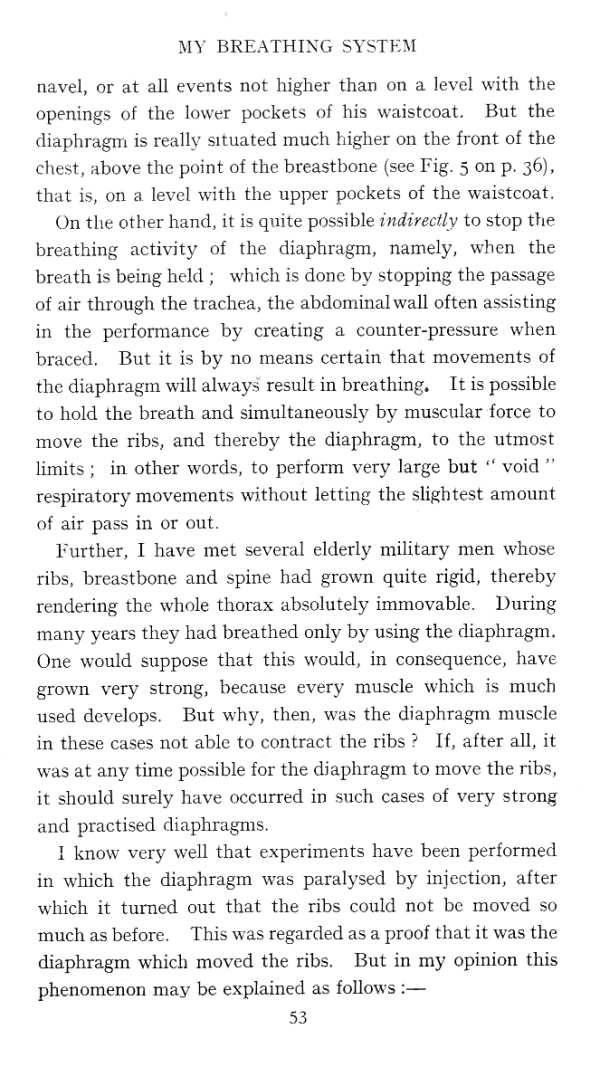mbs 053

MY BREATHING SYSTEM
navel, or at all events not higher than on a level with the openings of the lower pockets of his waistcoat. But the diaphragm is really situated much higher on the front of the ehest, above the point of the breastbone (see Fig. 5 on p. 36), that is, on a level with the upper pockets of the waistcoat.
On the other hand, it is quite possible indirectly to stop the breathing activity of the diaphragm, namely, when the breath is being held ; which is done by stopping the passage of air through the trachea, the abdominalwall often assisting in the performance by creating a counter-pressure when braced. But it is by 110 means certain that movements of the diaphragm will always result in breathing. It is possible to hołd the breath and simultaneously by muscular force to move the ribs, and thereby the diaphragm, to the utmost limits ; in other words, to perfonn very large but “ void ” respiratory movements without letting the slightest amount of air pass in or out.
Further, I have met several elderly military men whose ribs, breastbone and spine had grown quite rigid, thereby rendering the whole thorax absolutely immovablc. During many years they had breathed oniy by using the diaphragm. One would suppose that this would, in consequence, have grown very strong, because every muscle which is much used dcvelops. But why, then, was the diaphragm muscle in these cases not able to contract the ribs ? If, after all, it was at any time possible for the diaphragm to movc the ribs, it should surely have occurred in such cases of very strong and practised diaphragms.
I know very well that experiments have been performed in which the diaphragm was paralysed by injection, after which it turned out that the ribs could not be moved so much as before. This was regarded as a proof that it was the diaphragm which moved the ribs. But in my opinion this phenomenon may be explained as follows :—
53
Wyszukiwarka
Podobne podstrony:
mbs 027 MY BREATHING SYSTEM sucked in. For persons who lind it very difficult to acquire tłiis contr
mbs 111 MY BREATHING SYSTEM practised until it can be periormcd unconsciously. I havc never seen thi
mbs 084 MY BREATHING SYSTEM tliercfore, to be performed with the l)ody in difterent positions. At Wh
mbs 113 MY BREATHING SYSTEM diaphragmatic breathing during voluntary contraction. It should be done
52396 mbs 043 MY BREATHING SYSTEM when we spend our time in crowded halls in poisonous air, or are f
mbs 005 MY BREATHING SYSTEM BYLIEUT. J. P. MI LLER, K.D. Author of My System," " My System
mbs 011 MY BREATHING SYSTEM and violent palpitatiops. Sncli an overstrained licart could never last
mbs 014 MY BREATHING SYSTEM slow, regular respiration, even during the hardcst and most protracted e
więcej podobnych podstron